Paul Steenhof
-
- Arctic Standards Development Moves Ahead Marine News, Jan 2014 #28
Improving and updating Arctic design standards for material, equipment, and offshore structures for the petroleum, petrochemical and natural gas industries.
Seventy representatives from seven countries met for two days in St. John’s, Newfoundland and Labrador in early October to further the creation of standards for resource development in the Arctic. The countries represented included Canada, UK, France, Italy, Norway, Netherlands, and Russian Federation. It was the third annual meeting of the International Organization for Standardization’s (ISO’s) Technical Committee on Arctic Operations (ISO TC 67 SC8) which focused on advancements in standards with regard to (1) ice management (led by Canada), (2) escape, evacuation and rescue (Russia), (3) environmental monitoring (Russia), (4) working environment (Norway), (5) land extension and Arctic islands (Netherlands), (6) Arctic materials (Russia), and (7) physical environment (Norway). This technical committee is a follow-up to ISO 19906, which established Arctic design standards for material, equipment, and offshore structures for the petroleum, petrochemical and natural gas industries.
Out in Front
Recalling his first involvement in an ice management program in the Arctic in 2000-2001, Stephen Green commented on the current push to develop operations standards. He is Canadian chair of the ISO Canadian Mirror technical committee and general manager of Provincial Aerospace’s Environmental Services Division in St. John’s. “Now, with better technology,” Green said, “we are in a position to more effectively utilize oil and gas reserves, and with the reduction in Arctic ice, there is a commercial opportunity for shipping using the northern sea routes. The Arctic train is leaving the station,” he observed, “and you can’t stop it. You have three choices: You can either be on the train and influence its course, you can stay behind at the station, or you can be under the train.” He added that the technical committee’s focus is to be proactive and work together to develop standards for the protection of people, the environment, and assets. “Even if Canada decides not to drill in the Arctic,” Green said, “there’s drilling in western Greenland. We have an obligation to make sure that risk is minimized. When someone is drilling outside your borders, it becomes a global issue.”
The International Oil and Gas Producers Association (OGP) has championed the development of Arctic standards since the committee was struck in 2011, noted Green. Industry representatives at the meetings included individuals from OGP, Husky Energy, Statoil, BP, Chevron, Shell, Gazprom (Russia), ENI (Italy), and TOTAL SA (France). Representatives from Petroleum Research Newfoundland & Labrador, Canada-Newfoundland and Labrador Offshore Petroleum Board, BN Petrole AFNOR (France), and the Petroleum Safety Authority (Norway) also participated in the meetings, as did the Canadian Standards Association and Standards Norway.
The technical committee convenes plenary meetings twice a year. The first meeting was in Moscow in November 2012, the second in Rotterdam in April 2013, and the next meeting will be in Paris in April 2014. The work groups continue to collaborate between meetings.
Progress & Planning
On October 2, the work groups with representatives from each country reviewed their progress to date, outlined the work that needs to be completed, and began to develop work plans. Votes were cast in a plenary session on October 3, with each country having one vote. “Bringing together international experts face to face is an essential part of the international standards development process,” said Paul Steenhof, project manager for CSA Group (Canadian Standards Association). “By meeting together, we’re able to start developing the work plans. This often occurs through a negotiation process where face-to-face time is critical.” Once a New Work Item has been accepted by the Subcommittee, the standard for that item is typically scheduled to be completed in three years, said Steenhof. If a four-year development track is required, ISO is notified.
The Ice Management standard, for example, is set to be finalized by the end of June, 2016. Stephen Green is vice-chair of the ice management work group (Robin Browne of Chevron Canada is chair), which encompasses ice, currents, meteorology, and icebreaking and ice management operations utilizing remote sensing, aircraft sensor, and radar data. Their work will culminate in the creation of a manual that will include checklists that oil companies will use in the development of their ice management plans.
António Simões Ré who is Canadian vice-chair of the ISO technical committee and also working group lead of the escape, evacuation, and rescue work group, likened the decision making process to that of the United Nations. “Countries have different approaches to legislation,” he said. “For example, traditionally, the Russians tend to be more prescriptive while Canadians are more oriented towards performance-based, so you have to work through that.” Simões Ré, who is a senior research engineer at the National Research Council of Canada’s Ocean and Coastal Rivers Engineering facility in St. John’s, noted that the biggest challenge for his work group is addressing the requirements of both onshore and offshore operations. Whereas winter conditions are severe in the offshore areas, onshore operations may benefit from temporary infrastructure such as ice roads which facilitate evacuation. He doesn’t think the hazards and challenges of working at the different latitudes in the North can be addressed by improving on existing technologies.
“A step change is needed,” said Simões Ré. “We need new ways of doing things, due to the remoteness and lack of infrastructure. The solutions will need to be more self-sufficient and robust.” He foresees either the development of designs that are fitted for all hazards and conditions that work in all seasons—but that do not do anything exceptionally well—or multiple types of evacuation technology that will be tailored for each season. While Arctic operations won’t provide a high-volume market for new technologies, Simões Ré sees this as an opportunity for companies to showcase their design capabilities, which will likely lead to applications in less challenging environments.
St. John’s was chosen as the venue for the meetings in Canada due to the high concentration of harsh-environment expertise residents here. “This has been an opportunity for Newfoundland and Labrador to truly become the Arctic gateway,” said Green. “If we can survive on the Grand Banks, it’s a great testing ground for the Arctic.” He added that Newfoundland and Labrador has the highest per capita involvement on the technical committee internationally.
Companies located in the province that were represented at the meetings include: Provincial Aerospace, AMEC Environment & Infrastructure, AKAC Inc., Iceberg Logistics Inc., Rutter Inc., Oceans Ltd., Oceanic Consulting, Deltaradar, and Virtual Marine Technology. OceansAdvance, the organization that represents the ocean technology cluster in the province, coordinated the event. “The entry of the International Organization for Standardization into the Arctic equation can be seen as a strong affirmation that the region is on the cusp of major development,” said Les O’Reilly, executive director of OceansAdvance, “especially across the oil and gas industry, including the ocean technology sector.” The National Research Council of Canada (NRC) on the Memorial University campus hosted the event. Financial and logistical support for the October meetings was provided by NRC. Atlantic Canada Opportunities Agency and the Government of Newfoundland and Labrador’s Department of Innovation, Business and Rural Development provided financial support, and the City of St. John’s provided logistical support.
Bottom Line: Standards + Cooperation = Safety
Characterizing Canada’s effort with regard to the technical committee, Green said, “When it comes to the Arctic, we have the federal and provincial governments and the private sector working together. We’re all on the same oar, which does not happen in a lot of countries.” Steenhof said the Arctic is “a huge priority”—not only because of its high concentration of natural resources, but also because of the necessity to ensure sustainable economic development as well as environmental protection—noting a recent protest by Greenpeace in the Russian Arctic. “I attended a meeting last week with senior representatives of oil and gas producers,” he added, “and they emphasized the need for safe operations in the Arctic. Operational standards are of critical importance in this regard—to the oil companies in particular. They need the social license to operate in the Arctic, and standards help them achieve that.”
(As published in the January 2014 edition of Marine News - www.marinelink.com)
-
- The Quest for Arctic O&G Standards Marine Technology, Jan 2014 #26
having one vote. “Bringing together international experts face to face is an essential part of the international standards development process,” said Paul Steenhof, project manager for CSA Group (Canadian Standards Association). “By meeting together, we’re able to start developing the work plans. This often
-
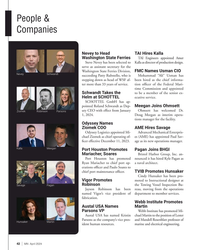 )
April 2024 - Marine News page: 42
)
April 2024 - Marine News page: 42Names Ziomek COO AME Hires Savage Odyssey Logistics appointed Mi- Advanced Mechanical Enterpris- chael Ziomek as chief operating of- es (AME) has appointed Paul Sav- ? cer effective December 11, 2023. age as its new operations manager. Kalla Meegan Port Houston Promotes Pagan Joins BHGI Mariacher, Soares Bristol
-
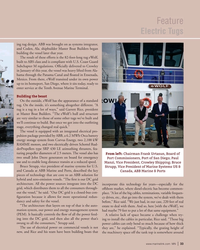 )
April 2024 - Marine News page: 33
)
April 2024 - Marine News page: 33vessel also has From left: Chairman Frank Urtasun, Board of two small John Deere generators on board for emergency Port Commissioners, Port of San Diego; Paul use and to enable long distance transits at a reduced speed. Manzi, Vice President, Crowley Shipping; Bruce Bruce Strupp, vice president of marine
-
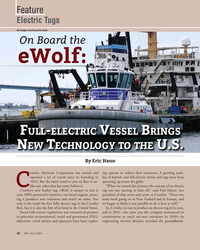 )
April 2024 - Marine News page: 32
)
April 2024 - Marine News page: 32. “When we started this journey, the concept of an electric Crowley’s new harbor tug, eWolf, is unique in that it tug was just starting to kick off,” said Paul Manzi, vice runs 100% powered by batteries, not diesel engines, mean- president of ship assist and escort at Crowley. “There was ing it produces zero
-
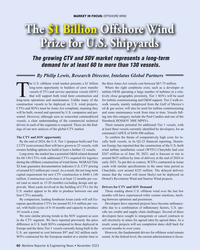 )
November 2023 - Maritime Reporter and Engineering News page: 60
)
November 2023 - Maritime Reporter and Engineering News page: 60per- and some maintenance work from time to time. Vessels fall- sonnel. However, although seen as somewhat commoditized ing into this category include the Paul Candies and one of the vessels, a clear understanding of the commercial technical Hornbeck HOSSOV 300E MPSVs. drivers in each of the segments is required
-
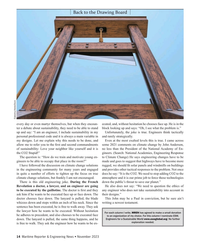 )
November 2023 - Maritime Reporter and Engineering News page: 14
)
November 2023 - Maritime Reporter and Engineering News page: 14him if he wants to be executed face up or face down. The their designs.” doctor chooses face down. The lanyard is pulled, the blade This John may be a Paul in conviction, but he sure ain’t whizzes down and stops within an inch of his neck. Since the writing a newest testament. sentence has been executed
-
 )
November 2023 - Maritime Reporter and Engineering News page: 12
)
November 2023 - Maritime Reporter and Engineering News page: 12triumph by con- exist to avert the destruction, but then we vincing its opponents and making them see the light, have those Sauls that refuse to become Pauls. but rather because its opponents eventually die and a new It is probably not unreasonable to state that with the scien- generation grows up that
-
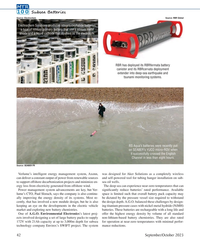 )
September 2023 - Marine Technology Reporter page: 42
)
September 2023 - Marine Technology Reporter page: 42temperatures that can Power management system advancements are key, but Ver- signi? cantly reduce batteries’ rated performance. Available lume’s CTO, Paul Slorach, says the company is also continu- space is limited such that overall battery pack capacity may ally improving the energy density of its systems
-
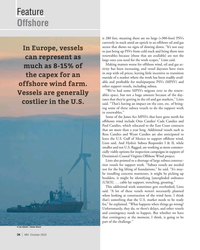 )
October 2023 - Marine News page: 34
)
October 2023 - Marine News page: 34vessels to do the support work in renewables.” Some of the Jones Act MPSVs that have gone north for offshores wind include Otto Candies’ Cade Candies and Paul Candies, which relocated to the East Coast contracts that are more than a year long. Additional vessels such as Ross Candies and Wyatt Candies are
-
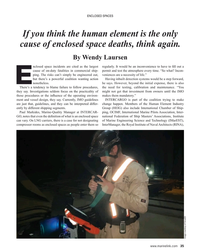 )
September 2023 - Maritime Reporter and Engineering News page: 35
)
September 2023 - Maritime Reporter and Engineering News page: 35differ- change happen. Members of the Human Element Industry ently by different shipping segments. Group (HEIG) also include International Chamber of Ship- Paul Markides, Marine-Quality Manager at INTERCAR- ping, OCIMF, International Marine Pilots Association, Inter- GO, notes that even the de? nition of what
-
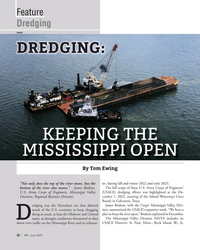 )
June 2023 - Marine News page: 32
)
June 2023 - Marine News page: 32threatened to shut The Mississippi Valley Division (MVD) includes six down river traf? c on the Mississippi River and its tributar- USACE Districts: St. Paul, Minn.; Rock Island, Ill.; St. 32 | MN June 2023 MN June23 Layout 32-45.indd 32 5/19/2023 3:11:36 P
-
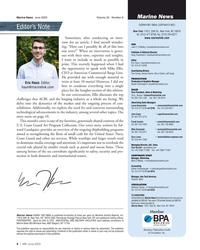 )
June 2023 - Marine News page: 4
)
June 2023 - Marine News page: 4attention, it’s important not to overlook the Managing Director, Intl. Sales crucial role played by smaller vessels such as patrol and rescue boats. These Paul Barrett • [email protected] Tel: +44 1268 711560 Fax: +44 1268 711567 unsung heroes of the sea contribute signi? cantly to safety, security and pro- CORPOR
-
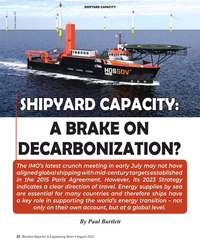 )
August 2023 - Maritime Reporter and Engineering News page: 22
)
August 2023 - Maritime Reporter and Engineering News page: 22many countries and therefore ships have a key role in supporting the world’s energy transition – not only on their own account, but at a global level. By Paul Bartlett 22 Maritime Reporter & Engineering News • August 2023 MR #8 (18-33).indd 22 8/3/2023 10:54:05 A
-
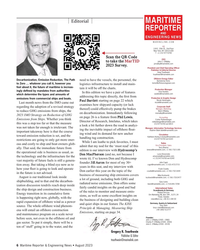 )
August 2023 - Maritime Reporter and Engineering News page: 6
)
August 2023 - Maritime Reporter and Engineering News page: 6and amounts of addressing this topic directly, the ? rst from Production & Graphic Design emissions from commercial ships and boats. Nicole Ventimiglia Paul Bartlett starting on page 22 which [email protected] Last month news from the IMO came out examines how shipyard capacity (or lack Corporate
-
 )
August 2023 - Maritime Reporter and Engineering News page: 4
)
August 2023 - Maritime Reporter and Engineering News page: 4$140.00; two years $180.00 (18 printed issues) including postage and handling. Bartlett experience as a journalist. She engineering applications. Paul Bartlett is a maritime jour- has a Master of Science research nalist and consultant with experi- degree in marine ecology as well Stagner CONTACT
-
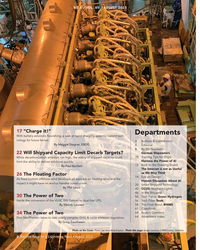 )
August 2023 - Maritime Reporter and Engineering News page: 2
)
August 2023 - Maritime Reporter and Engineering News page: 2high, the reality of shipyard capacity could Harness the Power of AI limit the ability to deliver solutions quickly. 12 Back to the Drawing Board: By Paul Bartlett The Internet is not as Useful as We May Think 26 The Floating Factor 14 Eye on Design: As fxed bottom offshore wind develops, all eyes
-
 )
August 2023 - Marine News page: 4
)
August 2023 - Marine News page: 4projects Tel: 516-441-7258 and the new innovations helping shipyards to do what they do best: get Managing Director, Intl. Sales the job done. Paul Barrett • [email protected] Tel: +44 1268 711560 Fax: +44 1268 711567 CORPORATE STAFF Manager, Marketing Mark O’Malley • momalley@marinelink
-
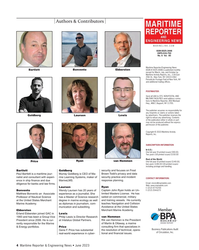 )
June 2023 - Maritime Reporter and Engineering News page: 4
)
June 2023 - Maritime Reporter and Engineering News page: 4year (9 printed issues) $140.00; two years $180.00 (18 printed issues) including postage and handling. Bartlett Goldberg security and focuses on Frost Paul Bartlett is a maritime jour- Murray Goldberg is CEO of Ma- Brown Todd’s privacy and data nalist and consultant with experi- rine Learning Systems,
-
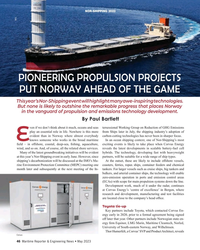 )
May 2023 - Maritime Reporter and Engineering News page: 46
)
May 2023 - Maritime Reporter and Engineering News page: 46. But none is likely to outshine the remarkable progress that places Norway in the vanguard of propulsion and emissions technology development. By Paul Bartlett ven if we don’t think about it much, oceans and seas tersessional Working Group on Reduction of GHG Emissions play an essential role in life
-
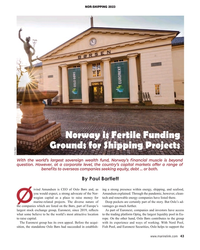 )
May 2023 - Maritime Reporter and Engineering News page: 43
)
May 2023 - Maritime Reporter and Engineering News page: 43. However, at a corporate level, the country’s capital markets offer a range of bene? ts to overseas companies seeking equity, debt … or both. By Paul Bartlett ivind Amundsen is CEO of Oslo Børs and, as ing a strong presence within energy, shipping, and seafood, you would expect, a strong advocate
-
 )
May 2023 - Maritime Reporter and Engineering News page: 26
)
May 2023 - Maritime Reporter and Engineering News page: 26growth for more than a decade this year and next. Protesters cause disruption but, for the moment, hydrocarbon energy underpins life as we know it. By Paul Bartlett 26 Maritime Reporter & Engineering News • May 2023 MR #5 (18-33).indd 26 5/1/2023 10:03:57 A
-
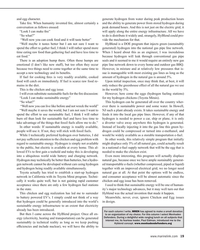 )
May 2023 - Maritime Reporter and Engineering News page: 19
)
May 2023 - Maritime Reporter and Engineering News page: 19a delightful wide ranging lunch on all subjects that ergy (electricity, heating and transportation) can be generated interest me, its fearless leader, Paul Eidman, introduced me to the sustainably (a technical reality as long as we keep pushing Hyblend concept. www.menhadendefenders.org ef? ciencies
-
 )
May 2023 - Maritime Reporter and Engineering News page: 6
)
May 2023 - Maritime Reporter and Engineering News page: 6a dedicated likely fraught with equal doses of failure International Sales Scandinavia & Germany vessel for Tohoku Electric Power Co. and success. As Paul Barlett opines in the Roland Persson Orn Marketing AB, Box 184 , S-271 24 The introduction of the Wind Challenger opening of his energy transition
-
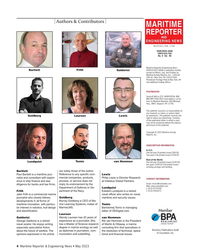 )
May 2023 - Maritime Reporter and Engineering News page: 4
)
May 2023 - Maritime Reporter and Engineering News page: 4full year (9 printed issues) $140.00; two years $180.00 (18 printed issues) including postage and handling. Bartlett are solely those of the author. Paul Bartlett is a maritime jour- Reference to any speci? c com- Lewis nalist and consultant with experi- mercial companies, products, Philip Lewis is
-
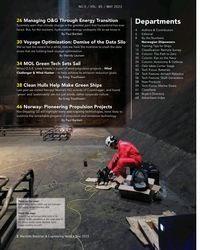 )
May 2023 - Maritime Reporter and Engineering News page: 2
)
May 2023 - Maritime Reporter and Engineering News page: 2is the greatest peril that humankind has ever faced. But, for the moment, hydrocarbon energy underpins life as we know it. 4 Authors & Contributors By Paul Bartlett 6 Editorial 8 By the Numbers: Norwegian Shipowners 30 Voyage Optimization: Demise of the Data Silo 10 Training Tips for Ships We’ve had
